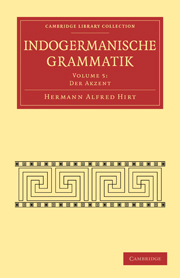Book contents
- Frontmatter
- Vorwort
- Contents
- Einleitung
- Erster Teil. Der Akzent der Einzelsprachen
- IV Kapitel. Das Griechische
- V Kapitel. Das Lateinische
- VI Kapitel. Das Keltische
- VII Kapitel. Das Germanische
- VIII Kapitel. Das Baltische
- IX Kapitel. Das Slawische
- X Kapitel. Die litu-slawischen Intonationen
- XI Kapitel. Der Hauptton im Litu-Slawischen im Vergleich zum Indogermanischen
- XII Kapitel. Das Armenische
- XIII Kapitel. Das Albanische
- XIV Kapitel. Das Indische
- XV Kapitel. Das Iranische
- Zweiter Teil. Der Akzent des Indogermanischen
- Autorenverzeichnis
- Sachregister
- Wörterverzeichnis
XIV - Kapitel. Das Indische
Published online by Cambridge University Press: 05 August 2011
- Frontmatter
- Vorwort
- Contents
- Einleitung
- Erster Teil. Der Akzent der Einzelsprachen
- IV Kapitel. Das Griechische
- V Kapitel. Das Lateinische
- VI Kapitel. Das Keltische
- VII Kapitel. Das Germanische
- VIII Kapitel. Das Baltische
- IX Kapitel. Das Slawische
- X Kapitel. Die litu-slawischen Intonationen
- XI Kapitel. Der Hauptton im Litu-Slawischen im Vergleich zum Indogermanischen
- XII Kapitel. Das Armenische
- XIII Kapitel. Das Albanische
- XIV Kapitel. Das Indische
- XV Kapitel. Das Iranische
- Zweiter Teil. Der Akzent des Indogermanischen
- Autorenverzeichnis
- Sachregister
- Wörterverzeichnis
Summary
Geschichtliches und Literaturübersicht. Unsere wichtigste Quelle für die Erscbließung der indogermanischen Betonung ist und bleibt das Indische. Nicht nur, daß wir hier eine Fülle alter akzentuierter Texte besitzen, nein, auch die Grammatiker berichten ausführlich über den Akzent und geben die Regeln der Betonung an. Dazu kommt, daß das Indische den Sitz des Haupttones im wesentlichen unverändert erhalten hat.
Die Beschäftigung mit dem Akzent wurde dutch Böhtlingks oben, § 5. erwähnte Arbeit eröffnet.
Ihr folgten weiter an gröβeren Arbeiten:
Aufrecht, De accentu sanscritico. Particula prima. Bonn 1847, rez. von Benfey, GGA. 1848, S. 1995 (Kl. Schr. 1, 109 ff.);
Haug, Über das Wesen und den Wert des wedischen Akzentes. München 1874;
R. Garbe. Das Akzentuationssystem des altindischen Nominalkompositums. KZ. 23, 470 ff.;
F. Knauer, Über die Betonung der Komposita mit a privativum im Sanskrit. KZ. 27, 1 ff.;
J. N. Reuter, Die altindischen Nominalkomposita, ihrer Betonung nach untersucht. KZ. 31, 157 ff., 485 ff.;
E. Leumann, Die Akzentuation der Çatapatha-Brāhmaṇa. KZ. 31, 22 ff.;
G. Burchardi, Die Intensiva des Sanskŗt und Awesta, I, 1892.
Dazu kommen natürlich die Handbücher, vor allem Whitneys altindische Grammatik hinsichtlich des tatsächlich Vorhandenen, während Wackernagel in dem ersten Band seiner Altindischen Grammatik 281 eine zusammenfassende Übersicht mit vollständigen Literaturangaben bietet.
Einzelne Probleme behandelt J. Wackernagel, Akzentstudien. I, Göttinger Nachr. d. Ges. d. Wiss. 1909, 50 ff., II, 1914, 20 ff. […]
- Type
- Chapter
- Information
- Indogermanische Grammatik , pp. 181 - 193Publisher: Cambridge University PressPrint publication year: 2009First published in: 1929



